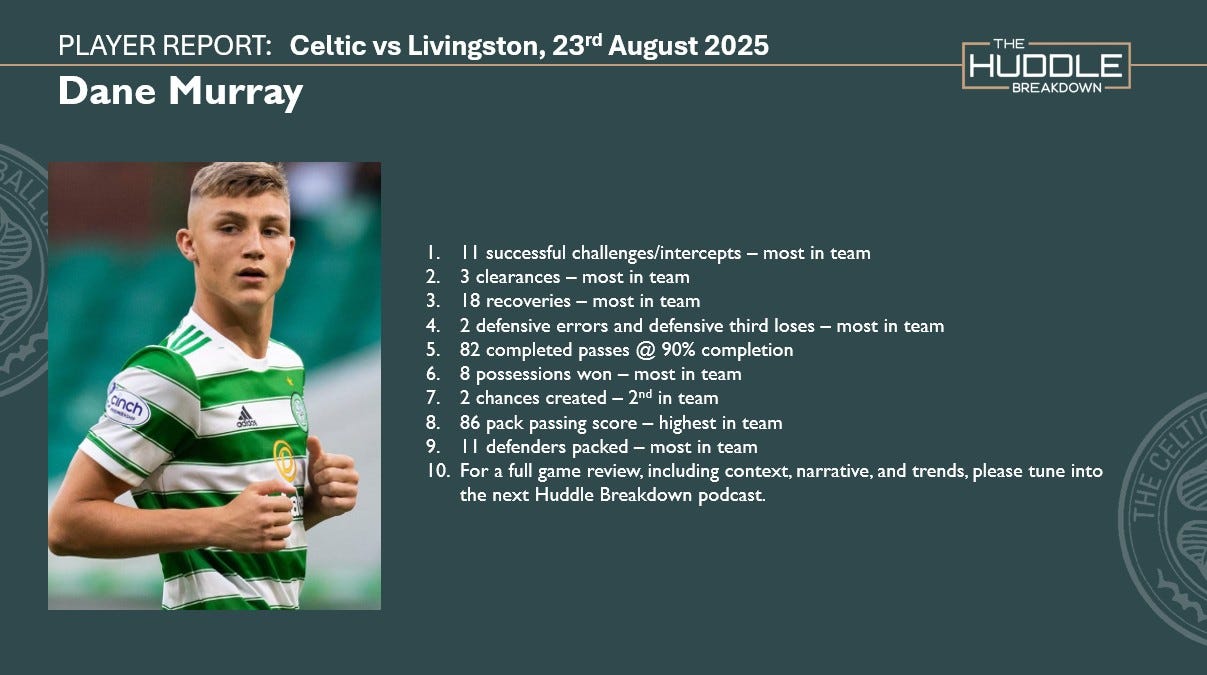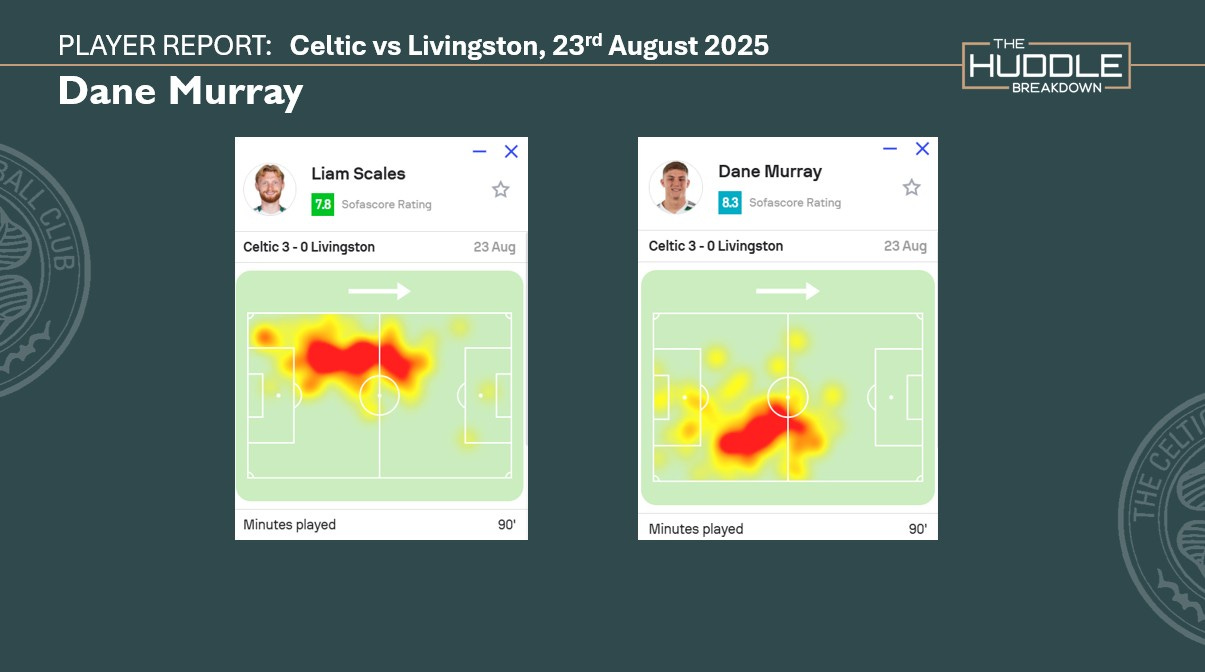First Impressions: Dane Murray
Three years after his Champions League Qualification debut, Dane Murray saw top-flight league action. Some first impressions.
Three years after making his debut in Champions League qualification against Midtjylland, Dane Murry made his SPFL debut against Livingston at Celtic Park.
Between those matches, Celtic has signed Liam Scales, Yuki Kobayashi, Maik Nawrocki, Lars Lagerbielke, Auston Trusty, Hayato Inamura, and had Moritz Jenz, Nat Phillips and Jahmai Simpson-Pusey on loan. Only the unheralded Scales has held down a regular starting spot. Perhaps there is a lesson here, and that a Celtic-level centre back was in the building all along?
Murray is 22 years old now and has recovered from two serious knee injuries to be here. He built up first-team minutes at Queens Park last season – 20 appearances and 1800 minutes — his first meaningful run as a professional.
Preparation for a hazardous trip to Kazakhstan necessitated squad rotation. And with Trusty injured and Cameron Carter-Vickers needing game managed, and Stephen Welsh seemingly surplus to requirements, Murray finally made his league bow.
Livingston presents aerial and physical challenges, while home games against this opponent also mean huge possession and, therefore, opportunities to demonstrate on-ball prowess.
As always, a firm opinion will be formulated after 900 minutes, but who doesn’t make a first impression?
Here are some highlights.
Let’s start with:
Must Do Better
Overall, his passing was bordering on excellent, as I will show, but it is a question of balance.
A 90% overall pass success rate is too low for a Celtic centre-back. He needs to aim for 95-96%. Celtic’s game model is all about control with progression. Given the high line they adopt, giving the ball away with high full-backs and advanced midfielders is very dangerous.
For Murray, this is about dialling in the right setting in the risk/reward assessment. He clearly has progressive passing ability, and so this is about tuning the decision-making to hit the accuracy threshold whilst still being expansive enough. It is a tough standard to reach.
This gets stressed when physically and mentally tired. Twice in the last 10 minutes of the game, he gave up possession in his defensive third in a central position. This is a no-no for a central defender.
He passed straight to Mo Sylla, who was able to run in on goal. Thanks to Sylla’s relative lack of pace, Murray was able to recover and effect a world-class saving tackle before the Livingston midfielder got a shot off. In Champions League play? Highly likely a goal.
In added time, he allowed Tete Yengi to dispossess him on the edge of Celtic’s penalty area. Callum McGregor was covering, and fortunately, Yengi shares the family tradition for poor technique and control, and Livingston did not get a shot off.
Allowance for it being his senior league debut, and with eight minutes of added time over the piece, a long shift. However, central defenders are the least stressed of outfield players in terms of kilometres covered and sprints completed. Not only does he need to be more risk-aware, but he also needs to improve his physical conditioning so as not to wilt so obviously in the last moments of games, when most goals are scored.
Those two moments netted him a pack turnover score of -38. That’s career-limiting if a trend. Last season, Carter-Vickers’ average pack turnover score was -5.35, and this wasn’t his best season. He had a TOTAL pack turnover score of -247 over an entire season.
Must Do More
Ok, into more positive aspects.
In terms of defending, Murray won five and lost one of his aerial duels. He won three and lost one of his ground duels – that being the aforementioned Yengi turnover.
Even above that, though, I enjoyed his reading of the game and ability to sweep up trouble along the back line. Here are his and Scales’ heatmaps from the game, courtesy of Sofascore.
The main takeaway is the coverage Murray afforded across the defensive line relative to his partner. 18 recoveries speak to positioning, anticipation, but also work rate and appreciation of what is happening around him and where he is needed to be to secure possession.
As those are all proxies for the hardest part of defending – decision-making and positional play – this is encouraging.
And what of the distribution?
14 pack passes were the third highest, but with a pack passing score of 86, he led the team.
Six of his 11 pack passes were to his right-sided forward. Five to Benjamin Nygren yielded a pack passing score of 40, and one to James Forrest seven. He put pace and accuracy into those passes down the line, breaking not just the initial press but also taking out the midfield four on five occasions.
Two passes from the back were off the seat moments and created shots. To Nygren in the 38th minute and to Shin Yamada in the 44th minute. Those removed seven and eight opponents, respectively, from the game. More of this, please.
Summary
At 6’ 4” and possessing a more bulked out frame, he’s some impressive unit now. He has the potential to be an aerially dominant monster, which, allied to footballing skills, is enticing.
Of course, it is early days and a home match against a likely relegation candidate club.
But the fundamentals look promising, and here’s hoping no more £3-4m wastes of money and he gets a chance to develop over the season.



